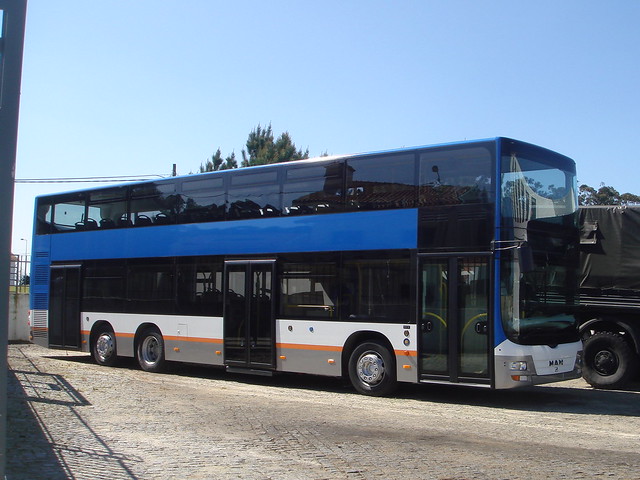E agora, algo completamente diferente.
Apesar do pessoal aqui ser mais fã do transporte individual, temos de estar em constante acompanhamento da evolução automóvel em todas as suas variantes.
Até mesmo quando toca a veículos cuja função é dar alternativas ao automovel privado.
Londres conseguiu transformar alguns dos seus transportes públicos em verdadeiros ícones.
Temos o típico Táxi londrino e claro, os vermelhissimos autocarros de 2 pisos.
Bem, chegou a altura de substituir o autocarro. Pode ser icónico, mas sabemos que no geral autocarros são criaturas desagradáveis, barulhentas, desconfortáveis, sujas.
Para responder a estas questões, foi lançado concurso já faz algum tempo para substituir o actual "double-decker", do qual saiu esta proposta vencedora, e agora, apresentada ao vivo e a cores.
virtual tour
YouTube - New Bus for London
o modelo apresentado
11111010211523141598x1030.jpg
11111010211537211600x1060.jpg
Visualmente inspirado pelo icónico Routemaster, é ao nivel das entranhas e acessibilidade que encontramos as novidades.
Construido à volta de uma estrutura space-frame em aluminio, trata-se de um hibrido do tipo "range-extender", em que o grupo motriz é eléctrico, movendo as rodas traseiras, auxiliado por um motor/gerador a diesel com 4,5l.
prevêm-se reduções siginificativas no que toca a ruido e emissões.
De modo a tornar a experiência mais agradável para o utilizador, foram ao pormenor de limitar o binário no arranque do autocarro, de modo a que o mesmo arranque sempre suavemente, sem esticões que possam desiquilibrar passageiros que estejam em pé. (hoje teria dado jeito durante a minha ida para o trabalho )
)
A acessibilidade sai melhorada, com o adicionar de 2 portas de acesso, regressa uma plataforma aberta na traseira, e tem 2 escadas de acesso ao piso superior. O objectivo é o de perder menos tempo possivel com a entrada e saída de passageiros.
Os primeiros protótipos deverão sair para testes no inicio do ano que vem, e para o final de 2011 é de esperar a entrada em serviço do primeiro exemplar.
No inicio de 2012 entrarão ao serviço mais 4 unidades, e o objectivo a médio prazo é substituir a frota dos 8000 "double-deckers" que actualmente andam pela cidade de Londres.
Apesar do pessoal aqui ser mais fã do transporte individual, temos de estar em constante acompanhamento da evolução automóvel em todas as suas variantes.
Até mesmo quando toca a veículos cuja função é dar alternativas ao automovel privado.
Londres conseguiu transformar alguns dos seus transportes públicos em verdadeiros ícones.
Temos o típico Táxi londrino e claro, os vermelhissimos autocarros de 2 pisos.
Bem, chegou a altura de substituir o autocarro. Pode ser icónico, mas sabemos que no geral autocarros são criaturas desagradáveis, barulhentas, desconfortáveis, sujas.
Para responder a estas questões, foi lançado concurso já faz algum tempo para substituir o actual "double-decker", do qual saiu esta proposta vencedora, e agora, apresentada ao vivo e a cores.
virtual tour
YouTube - New Bus for London
o modelo apresentado
11111010211523141598x1030.jpg
11111010211537211600x1060.jpg
Visualmente inspirado pelo icónico Routemaster, é ao nivel das entranhas e acessibilidade que encontramos as novidades.
Construido à volta de uma estrutura space-frame em aluminio, trata-se de um hibrido do tipo "range-extender", em que o grupo motriz é eléctrico, movendo as rodas traseiras, auxiliado por um motor/gerador a diesel com 4,5l.
prevêm-se reduções siginificativas no que toca a ruido e emissões.
De modo a tornar a experiência mais agradável para o utilizador, foram ao pormenor de limitar o binário no arranque do autocarro, de modo a que o mesmo arranque sempre suavemente, sem esticões que possam desiquilibrar passageiros que estejam em pé. (hoje teria dado jeito durante a minha ida para o trabalho
A acessibilidade sai melhorada, com o adicionar de 2 portas de acesso, regressa uma plataforma aberta na traseira, e tem 2 escadas de acesso ao piso superior. O objectivo é o de perder menos tempo possivel com a entrada e saída de passageiros.
Os primeiros protótipos deverão sair para testes no inicio do ano que vem, e para o final de 2011 é de esperar a entrada em serviço do primeiro exemplar.
No inicio de 2012 entrarão ao serviço mais 4 unidades, e o objectivo a médio prazo é substituir a frota dos 8000 "double-deckers" que actualmente andam pela cidade de Londres.




























Comentário